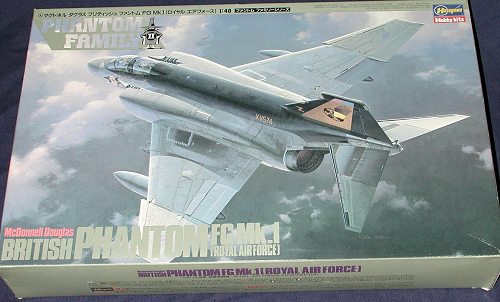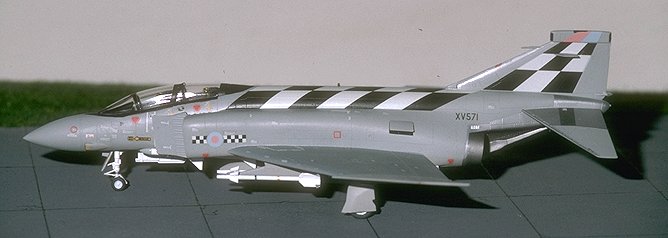
|
KIT: |
Hasegawa 1/48 FG.1 Phantom II |
|
KIT # |
P 17 |
|
PRICE: |
@£26.00 |
|
DECALS: |
Three aircraft |
|
REVIEWER: |
|
|
NOTES: |

|
HISTORY |
Following on from some of the frankly disastrous political decisions made in the UK in the 50’s and 60’s, and in particular the cancellation in 1964 of Hawker Siddeleys P.1154 (RN) the Royal Navy found itself without a replacement for its aging Sea Vixens.
Previous to this some personnel with vision in McDonnell had launched an overseas marketing effort one of the main points was to actually target the UK as possible user of the F-4 Phantom.
It became apparent that an RN Phantom would require a higher attitude on launch, a slower approach speed, and greater power. For this McDonnell designed a nose oleo with a double extension, the aircraft was also given a strengthened undercarriage, 16 ½ degree drooped ailerons, enlarged leading edge flaps (both with BLC), stabilator slots and reduced stabilator anheadral. Unique improvements also included a folding radar and radome (for smaller lifts on UK aircraft carriers), pylons stressed to carry 1000lb bombs, and a strengthened arrestor hook. All aircraft were initially fitted with Martin Maker Mk H5 ejection seats; these were though upgraded to the same H7 standard as those in USN F-4J’s thus providing true Zero-Zero capability.
The main change though would be the use of the Rolls Royce Spey engine as the main power plant.
Replacing a home grown project such as the P.1154 with an American aircraft would be a bitter blow, as such Britain demanded a high content of British parts to ease the blow to the UK aircraft industry. The adoption of the Spey necessitated some major changes; these included new intake ducts (at least 6 inched wider) to accommodate the greater airflow, new engine intakes ramps and a redesigned engine bay. The Spey gave a 10% increase in operational radius, a 15% increase in ferry range, and better take off, initial climb and low-level acceleration figures. On the other side of the coin the maximum speed dropped from Mach 2.1 to Mach 1.9, and ceiling, performance at altitude, and afterburner light-up time deteriorated. One major downside of all these changes was that Britain had to shoulder all the development costs of the Spey Phantom resulting in a very high unit cost.
Following a rapid rundown of the UK carrier force (A fire in HMS Victorious which was deemed prohibitively too expensive to repair, and the refit to HMS Eagle was deemed the same) only HMS Ark Royal was left as a Phantom platform. Therefore half the RN’s F-4K’s (or FG.MK1) were transferred to the Royal Air Force. These were sent to 43 Squadron at RAF Leuchars. All aircraft transferred tot eh RAF were made compatible with the SUU-23 gun pod. Following on with further Phantom integration into the RAF MK1’s were subsequently transferred to 111 Squadron.
|
THE KIT |
 |
 |
The kit comes on seven grey plastic sprues and one clear one, also included are cast metal front and main wheels with rubber tyres. There is little or no flash present anywhere. Ejection pin marks seem to have been confined to the inside of parts in the whole, there are a couple on some landing gear parts but they are fairly easy to clean away.
On to the kit itself, the aircraft has raised engraved detail throughout. The cockpit looks to be fairly standard though I must admit I have not checked it for accuracy against reference (though to my knowledge there is no aftermarket cockpit for UK phantoms). The kit features a 5 part ejection seat which while they don’t have any kind of belts do come with the top ejection handles which I hate making. I would though suspect that the addition of a couple of aftermarket Martin Bakers would make a great deal of difference (I know I intend to do this). The instrument panels and side consoles all come with raised detail. You will need to paint this as no instruments decals are provided.
Most of the main parts are, as you would expect them. Two fuselage halves with a center split, one-piece bottom center wing and two-piece top wing. There is a small amount of detail moulded into the wheel wells and the landing gear struts are well moulded. The airbrakes can be positioned down if you want to along with the flaps.
Weapons and externals are generally good. Supplied are a centerline large tank with molded pylon, two wing tanks with molded pylons, 4 sparrow missiles, and an SUU-23 centerline gun pod. As usual with Hasegawa kits the instructions invite you to purchase the Weapons sets if you want to add sidewinder missiles. Also included is an EMI centerline reconnaissance pod, which is not used for this kit (one for the spares bin!).
The canopy is in 4 parts and is quite thin; the pieces are well moulded with no seam lines and should present no problems.
Instructions are the usual Hasegawa fold out ones with the main build instructions on one side and painting / decal placement on the reverse.
Decals / Paint Schemes.
 For paint schemes all three aircraft use the standard RAF
low vis colours of Light Aircraft Grey / Medium Sea
Grey and Barley Grey. As usual with many Hasegawa kits a
colour painting guide is supplied of what they consider to be the main
scheme, in this kit it refers to option 1 as listed below.
For paint schemes all three aircraft use the standard RAF
low vis colours of Light Aircraft Grey / Medium Sea
Grey and Barley Grey. As usual with many Hasegawa kits a
colour painting guide is supplied of what they consider to be the main
scheme, in this kit it refers to option 1 as listed below.
The decals appear to be the usual Hasegawa offerings. The white is not white but more an Ivory colour. There are three schemes on offer on the sheet;


Fujimi 1/72 FG.1 in these markings: Decals by Modeldecal
In conclusion for the decals, some are usable, but the serious modeler will look for aftermarket replacements.
|
CONCLUSIONS |
This is a very good standard Hasegawa kit which will build into a good looking model. It is however let down by the ever present (or never present) lack of under wing stores, and by the quality of the decal sheet. Get yourself a couple of aftermarket ejection seats and a good quality decal sheet and this will make a great model.
I would recommend this kit. It looks fairly simple and anyone with even basic skills should be able to make a good job of it.
If you would like your product reviewed fairly and quickly by a site that has well over 175,000 visitors a month, please contact me or see other details in the Note to Contributors.